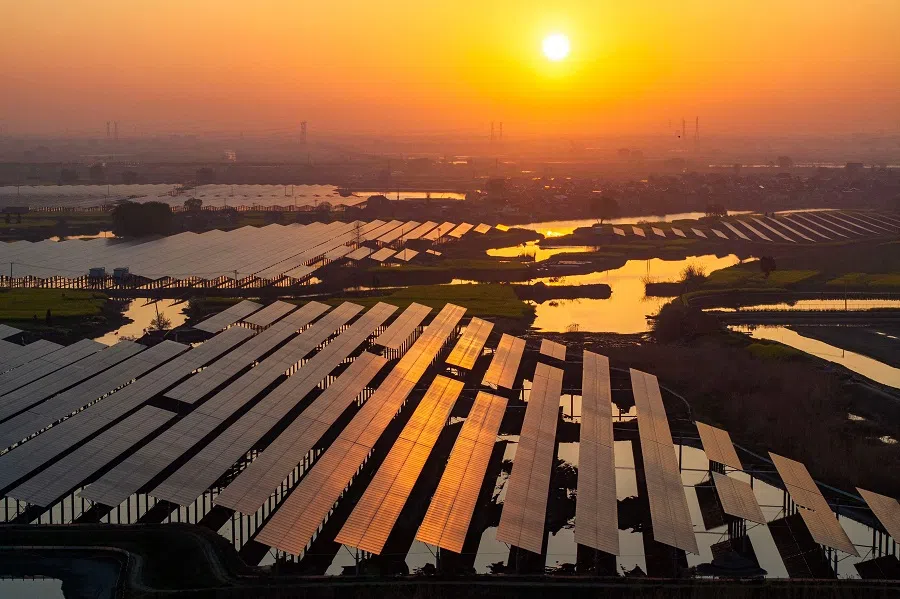Unmet climate goals: Why China still falls short of global leadership
While many are looking to China to fill the void left by the US, recent developments suggest that China may not yet be ready to take up the mantle of global climate leadership, says EAI deputy director Chen Gang.

The global climate leadership landscape has been in flux, particularly ever since US President Donald Trump announced the withdrawal of his country from the Paris agreement yet again. The shift left a leadership vacuum that many expected China to fill, given its significant investments in renewable energy and its ambitious net zero goal. However, recent developments, including China’s missed emission targets in 2024, suggest that China may not yet be ready to assume the mantle of global climate leadership.
Difficult balancing act: economy and environmental commitments
China’s climate strategy has been characterised by ambitious pledges, such as achieving carbon neutrality by 2060 and peaking carbon emissions before 2030. These commitments are supported by substantial investments in renewable energy technologies, positioning China as a leader in the global green transition effort. However, the reality of meeting these targets has proven challenging.
This shortfall underscores the difficulties China faces in balancing its economic growth with its environmental commitments.
In 2024, China’s carbon intensity, a measurement of carbon emissions per unit of gross domestic product (GDP), fell by only 3.4%, missing the official target of 3.9%. China is also behind its five-year goal of slashing carbon intensity by 18% between 2020 and 2025.
This shortfall underscores the difficulties China faces in balancing its economic growth with its environmental commitments. As China’s GDP is decelerating, the government needs to cut emissions more aggressively to achieve the carbon intensity target set previously.

In recent years, the reliance on industrial growth to recover from the economic repercussions of the Covid-19 pandemic has led to increased energy demand and, consequently, higher emissions in China. This situation is compounded by domestic coal consumption, which remains a significant barrier to its climate leadership aspirations.
Despite pledges to halt overseas coal projects, domestic coal burning still accounts for more than half of China’s energy consumption and two-thirds of its electricity output. This reliance on coal poses a challenge to China’s ability to drastically reduce emissions and transition to cleaner energy sources.
Emerging as the world’s largest electric vehicle (EV) market and producer, China needs to charge its EVs with electricity from renewable sources like wind and solar rather than coal burning. Otherwise, the carbon footprints of these EVs may be even larger than cars with gasoline engines.
Achieving carbon neutrality will require significant reforms in China’s energy sector and broader economy, which may not occur until after 2035.
Significant reforms needed
While China has made remarkable achievements in the development of renewable energy like wind, solar and hydro power, the pace of structural changes needed to fully transition away from coal is far from satisfactory. Achieving carbon neutrality will require significant reforms in China’s energy sector and broader economy, which may not occur until after 2035. This timeline raises questions about China’s ability to lead global climate efforts in the near term.

Despite the current US administration’s climate position, it is important for China to maintain climate and energy cooperation with the US and the EU, which helps the country improve its image and potentially seek global leadership. However, China’s current domestic challenges and missed targets indicate that it may not yet be ready to fully assume this role. The international community will continue to closely watch China’s mitigation actions, as its success or failure will have significant implications for global efforts to combat climate change.
Moreover, China’s geopolitical strategies and economic policies add complexity to its climate leadership ambitions. The Belt and Road Initiative (BRI), while promoting infrastructure development, has been criticised for supporting projects that may not align with global mitigation or adaptation goals. The initiative’s prioritisation of economic expansion sometimes overshadows environmental considerations, posing a challenge to China’s ability to lead by example in climate efforts.
Domestic concerns may impede China’s global climate leadership role
China’s approach to climate leadership is further complicated by its domestic socioeconomic priorities. Although the key is to have sustainable and green growth, the government’s need to maintain a 5% GDP growth in 2025 may take precedence over environmental concerns. This prioritisation can lead to policy decisions that favour short-term economic gains over long-term sustainability, affecting China’s credibility as a climate leader. Lack of an active civil society that supports environmental activism and supervises government and corporate behaviours is weakening the country’s ability to take costly but necessary mitigation actions.
China, with the world’s second largest computing power scale, witnesses an annual growth of 15% in its data centres’ power usage, which accounts for about 4% of the national electricity consumption in 2025.
Additionally, the energy and environmental impact of China’s technological advancements in AI-driven solutions is contingent on the integration of more low-carbon energy into the local energy networks. China, with the world’s second largest computing power scale, witnesses an annual growth of 15% in its data centres’ power usage, which accounts for about 4% of the national electricity consumption in 2025.
Paradoxically, the role of AI in optimising intermittent renewable energy supply and improving energy efficiency is also a critical component of China’s climate strategy.

AI advancements could aid climate adaptation and mitigation
China’s technological advancements in AI offer potential solutions for climate adaptation and mitigation. AI can optimise renewable energy production, improve energy efficiency and provide actionable insights for governance, enabling data-driven policymaking for more effective interventions aimed at addressing inclusive growth issues. This scalable model for energy efficiency shows promise, but its implementation on a national scale in China is still nascent.
China’s collaboration with other nations is crucial for the country’s climate leadership. Engaging China for sustainability in Asia requires partnership and cooperation among Asian and Western economies. Solidifying mutual trust through cooperation on shared interests like climate change and green economic transition is essential for China to enhance its leadership role.
With the absence of the US, global actions against climate change urgently need the unity and consensus between China and other major players like the EU and ASEAN. China needs to kickstart strategic dialogues with these blocs on climate and energy issues as soon as possible.
China’s interest in low-carbon energy sectors in Southeast Asia a boon
China’s ambition to become a major provider of capital, construction services, and equipment to low-carbon energy sectors in Southeast Asia is another facet of its potential climate leadership. Chinese companies have been active in energy-related construction services, equipment, and investments in conventional energy projects, including low-carbon hydropower and grid construction. The transition from conventional to new energy projects has just started, and the pace of this transition will significantly impact China’s ability to lead in global climate efforts.
While China has made strides in green transition, its missed emissions targets and ongoing reliance on coal suggest that it is still not prepared to take on global climate leadership.

The falling costs of solar and wind energy, partly driven by low-cost manufacturing of related products in China, have energised the expansion of renewables globally. This trend has been particularly evident in many Western countries, where the cost of installing solar and wind generators has decreased significantly, making them more competitive with traditional energy sources. China’s role in driving down these costs highlights its potential to influence global renewable energy markets positively. Nevertheless, the tariffs levied by President Trump are complicating the global supply chain issue and weakening China’s role as the major supplier of renewable energy equipment.
While China has made strides in green transition, its missed emissions targets and ongoing reliance on coal suggest that it is still not prepared to take on global climate leadership. The international community needs to press China for more aggressive actions home and abroad, as its success or failure will have significant implications for global efforts to combat climate change. China’s journey towards climate leadership is a complex interplay of domestic challenges, technological advancements and international relations, all of which must be navigated carefully to achieve substantial progress.





